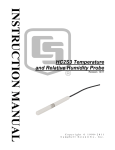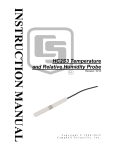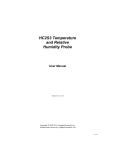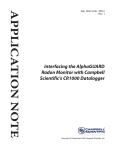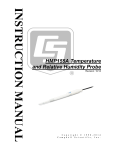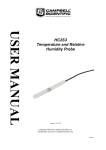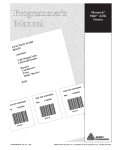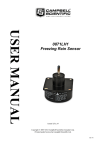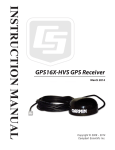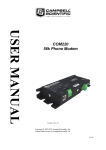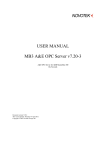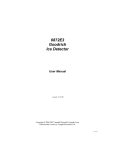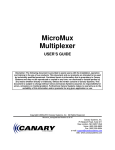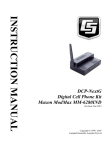Download Campbell SDM-CAN Specifications
Transcript
SDM-SIO1 Serial Input/Output Module 3/08 C o p y r i g h t © 2 0 0 8 C a m p b e l l S c i e n t i f i c , I n c . Warranty and Assistance The SDM-SIO1 SERIAL INPUT/OUTPUT MODULE is warranted by CAMPBELL SCIENTIFIC, INC. to be free from defects in materials and workmanship under normal use and service for twelve (12) months from date of shipment unless specified otherwise. Batteries have no warranty. CAMPBELL SCIENTIFIC, INC.'s obligation under this warranty is limited to repairing or replacing (at CAMPBELL SCIENTIFIC, INC.'s option) defective products. The customer shall assume all costs of removing, reinstalling, and shipping defective products to CAMPBELL SCIENTIFIC, INC. CAMPBELL SCIENTIFIC, INC. will return such products by surface carrier prepaid. This warranty shall not apply to any CAMPBELL SCIENTIFIC, INC. products which have been subjected to modification, misuse, neglect, accidents of nature, or shipping damage. This warranty is in lieu of all other warranties, expressed or implied, including warranties of merchantability or fitness for a particular purpose. CAMPBELL SCIENTIFIC, INC. is not liable for special, indirect, incidental, or consequential damages. Products may not be returned without prior authorization. The following contact information is for US and International customers residing in countries served by Campbell Scientific, Inc. directly. Affiliate companies handle repairs for customers within their territories. Please visit www.campbellsci.com to determine which Campbell Scientific company serves your country. To obtain a Returned Materials Authorization (RMA), contact CAMPBELL SCIENTIFIC, INC., phone (435) 753-2342. After an applications engineer determines the nature of the problem, an RMA number will be issued. Please write this number clearly on the outside of the shipping container. CAMPBELL SCIENTIFIC's shipping address is: CAMPBELL SCIENTIFIC, INC. RMA#_____ 815 West 1800 North Logan, Utah 84321-1784 CAMPBELL SCIENTIFIC, INC. does not accept collect calls. SDM-SIO1 Table of Contents PDF viewers note: These page numbers refer to the printed version of this document. Use the Adobe Acrobat® bookmarks tab for links to specific sections. 1. Introduction..................................................................1 2. Specifications ..............................................................2 2.1 Supported Data Rates and Protocols.........................................................2 2.2 Electrical Parameters ................................................................................3 2.2.1 SDM-SIO1 Current Consumption ..................................................3 2.2.2 SDM-SIO1 Voltage Specifications.................................................4 2.2.3 EMC Compliance............................................................................4 2.3 Temperature and Humidity Ranges ..........................................................5 2.4 Physical Parameters ..................................................................................5 2.5 Datalogger Compatibility .........................................................................5 3. Installation....................................................................5 3.1 Connections ..............................................................................................6 3.2 Safety Considerations ...............................................................................8 3.3 Examples for Connecting the SDM-SIO1 to Other Equipment................9 3.3.1 RS-485 One to One Connection Example ......................................9 3.3.2 RS-485 Multi Unit / In Line Example ..........................................10 3.3.3 RS-485 Half Duplex Wiring Example ..........................................11 3.3.4 RS-485 Internal Circuit Diagram..................................................11 3.3.5 RS-232 Wiring Example with Handshaking.................................12 3.3.6 RS-232 Basic 3-Wire Example .....................................................12 3.3.7 Connecting a 9-Way Socket to the SDM-SIO1 ............................13 3.4 Power Conservation................................................................................13 4. Programming the Datalogger ...................................14 4.1 Special Information about the Serial I/O CRBasic Commands when used with the SDM-SIO1 .............................................................................14 4.1.1 SerialOpen ....................................................................................14 4.1.2 SerialClose ....................................................................................17 4.1.3 SerialIn..........................................................................................17 4.1.4 SerialOut .......................................................................................17 4.1.5 SerialInBlock ................................................................................17 4.1.6 SerialOutBlock..............................................................................18 4.1.7 SerialInChk ...................................................................................18 4.1.8 SerialInRecord ..............................................................................18 4.1.9 SerialFlush ....................................................................................18 4.1.10 Serial Input Errors.......................................................................18 4.2 Configuring Handshaking and Receive Only Modes .............................18 4.2.1 Using RTS/CTS and Automatic Handshaking..............................18 4.2.2 RS-485 Half-Duplex Mode...........................................................19 4.2.3 Using the RS-232 Link in Receive Only Mode ............................19 i SDM-SIO1 Table of Contents 4.3 Example Datalogger Programs .............................................................. 19 4.3.1 Example Using RS-232 Mode...................................................... 20 4.3.2 Example Using RS-485 Mode...................................................... 21 5. Firmware Upgrades and Flash Signature Errors ....22 5.1 Upgrading the Firmware ........................................................................ 22 5.2 Firmware Signature Errors..................................................................... 22 Appendix A. Using the Handshaking Lines for General Input/Output .......................................................... A-1 A.1 The Input Pin (Pin 8)........................................................................... A-1 A.2 The Output Pin (Pin 9) ........................................................................ A-2 Tables 3-1. SDM Address Settings............................................................................ 6 3-2. SDM-SIO1 Connections (left to right as viewed from the front of the unit) ............................................................................................... 7 3-3. SDM-SIO1 Functional Description of the Connections ......................... 7 4-1. Communications Port Parameters RS-232............................................ 15 4-3. Communications Port Parameters RS-485 Half Duplex....................... 16 4-4. Communications Port Parameters RS-232 Receive Only Mode .......... 16 ii SDM-SIO1 Serial Input/Output Module The SDM-SIO1 Module is designed to allow expansion of the number of serial ports available on a datalogger for communicating with intelligent sensors or driving external displays. 1. Introduction The SDM-SIO1 Module connects to Campbell Scientific dataloggers using the SDM port and communication protocol. It connects to the remote serial device using industry standard hardware that can be set to RS-232, RS-485 or RS-422 signal levels. When operating in RS-232 mode it also supports hardware handshaking. RS-422 mode is functionally the same as RS-485 mode except the connection is limited to a point to point system. Connections and programming for RS-422 are otherwise identical to RS-485. The SDM-SIO1 will accept serial data and store it in its buffer which is 2047 bytes in size allowing remote equipment to transmit large amounts of data without needing to stop other processes in the datalogger. Up to 15 SDM-SIO1 peripherals can be connected to a single logger using the SDM port, allowing the user to connect 15 different items of equipment to their logger with ease, in addition to any connections made to the datalogger’s other serial ports. To start using the SDM-SIO1 it is first necessary to work out how data will be exchanged with a sensor. In the case of a sensor there are basically two options, either the datalogger requests data and then picks up the response, or the sensor transmits data “one-way” using its own time base. The latter mode is more common but can lead to problems with synchronizing the sensor measurements with the logger program and can also lead to the occasional missing data value as there are two independent clocks. Once the method of communication and the communication standard is defined then refer to section 3 below to install the module and connect it to the datalogger and the serial device. The SDM-SIO1 Module is implemented in such a way that it looks like a builtin serial port to the user when writing programs in CRBasic. This means all the user needs to do is define the address of the SDM-SIO1, using a rotary switch on the side of the unit. The serial port can then be used as if it were built into the datalogger. The only difference in operation between the SDM-SIO1 and a built-in port is that there will be a small delay when transferring data to and from the device via the SDM connection (see section 4.1). The SDM-SIO1 can also be used in ‘talk-through’ mode to allow a user to talk, via a terminal module, to a sensor connected to the SDM-SIO1 for test and diagnostic purposes. Please refer to the logger manual for further details. Section 4 of this manual gives the differences in the use of this module compared to the datalogger standard serial ports, plus there are some simple examples. 1 SDM-SIO1 Serial Input/Output Module 2. Specifications 2.1 Supported Data Rates and Protocols Data rates and protocols are set up using the SerialOpen command in CRBasic. The SerialOpen command is discussed elsewhere in this document. Supported data rates 300, 1200, 2400, 4800, 9600, 19200, 38400, 57600, and 115200 bits/s Supported modes of operation RS-232 (Full duplex and receive only), RS-485 (Half and full duplex), RS- 422 (Half and full duplex). Hardware CTS/RTS flow control is supported in RS232 mode, the handshaking lines can also be used as general purpose I/O lines. Supported data format 8, and 7 bit data size* none, odd, or even parity one or two stops bits. * In 7 bit mode with no parity the user must insure that the characters received by the SDM-SIO1 have a delay of at least one bit period or greater between them. This does not affect any other configuration and does not affect transmissions out of the SDM-SIO1. Miscellaneous information • Auto baud rate detection is NOT supported • Use of the serial port for general PakBus communications is not currently supported. Buffer sizes 2 • Transmit buffer size: 767 Bytes (Buffer from the logger to the sensor) • Receive buffer size: 2047 Bytes (Buffer from the sensor to the logger) Both transmit and receive buffers are fill and discard type, i.e. once the buffers become full no new information is accepted and all further data is discarded until space is made when the logger requests data from the SDM-SIO1. SDM-SIO1 Serial Input/Output Module 2.2 Electrical Parameters 2.2.1 SDM-SIO1 Current Consumption Nominal Max Notes 100 µA Current after SerialClose has been called. General Currents Standby current 70 µA RS-232 and RS-485 Current Consumption(1) Idle current 5.5 mA 6 mA After SerialOpen has been called Idle current (receive only) 4.1 mA 4.5 mA After SerialOpen in receive only mode Active current (RS232) 11.5 mA 12 mA Active RS-232 command Active current (RS485) 12.5 mA 13 mA Active RS-485 command (no termination resistors) 3 mA per load Average expected increase in drawn current per RS-232 line connected in idle or active modes (no extra current in stand-by mode). Line Load Currents RS-232 line load 2 mA per load Both TX and RTS are considered to be RS-232 loads. RS-485 line load(2) 40 mA(3) 77 mA(4) This extra current is only present when actively transmitting (1) All currents are measured with no loads connected (2) The RS-485 transmit pair is disabled when not transmitting in order to save power higher value resistors can be used to save power dependent upon the application. For many applications, especially with shorter cable runs, no load/termination resistors will be needed. (3) Single 100R load between transmit lines. Two 100R resistors (one on each end) is the maximum recommended loading. Removing any termination resistance should dramatically decrease current consumption during transfer of data (4) The RS-485 interface is protected against short circuits via a 44R resistance making this the maximum current possible even during short circuit. This resistance is part of the ESD protection circuitry and will be present at all times; it shouldn’t affect normal circuit operations. The ‘RS-485 internal circuit diagram’ in section 3.3.4 of this manual shows the circuit in detail. 3 SDM-SIO1 Serial Input/Output Module 2.2.2 SDM-SIO1 Voltage Specifications Minimum Voltage(1) Nominal Voltage(1) Maximum Voltage(1) Power supply, +12 V connection(2) 7V 12 V 20 V RS-232 input threshold Low 0.8 V - - RS-232 input threshold High - - 2.4 V RS-232 input absolute maximum(2) - ±15 V ±18 V RS-232 input resistance 3 kΩ 5 kΩ 7 kΩ RS-232 output voltage swing(3) ±5 V ±5.4 V - RS-232 output absolute maximum - - ±13.2 V RS-485 input (Differential) 200 mV(4) - 6V RS-485 output (Differential) 2 V (at 50 Ohms) - - SDM lines (high level) 4.3 V 5V 5.7 V SDM lines (low level) 0V - 0.7 V Connection (1) Values are volts D.C. (except resistances) (2) It is NOT recommended that the user runs their SDM-SIO1 at maximum ratings for extended periods of time (3) Assuming a worst case 3 KΩ load (4) It is not recommended that the user allows such low input voltages as there will be an increased chance that external noise may cause errors in the incoming data 2.2.3 EMC Compliance The SDM-SIO1 has been tested and shown to comply with IEC 61326. The device incorporates transient and surge protection that is designed to meet IEC61000-4-5, level 4, providing the device is adequately grounded. 4 SDM-SIO1 Serial Input/Output Module 2.3 Temperature and Humidity Ranges Temperature Range Minimum Maximum Standard range -20ºC +50ºC Extended range (optional) -40ºC +80ºC (Contact Campbell Scientific for further extended temperature requirements) Humidity Minimum Maximum Notes Standard range 0% 95% (non-condensing) Notes 2.4 Physical Parameters Main body Height: 2.2” H (5.4 H cm) Width: 3.1” W (8.0 W cm) Depth: 1.0” D (2.5 D cm) Main body including base mounting flange Height: 2.2” H (5.4 H cm) Width: 4.5” W (11.2 W cm) Depth: 1.0” D (2.5 D cm) Weight: 2.8 oz. (80 g) (approximately) Mounting centers are 10.2 cm (4”) 2.5 Datalogger Compatibility The SDM-SIO1 is currently supported in operating systems of the CR800/850, CR1000 and CR3000 dataloggers. Please contact Campbell Scientific for details of support in the CR5000 and CR9000X, which may be made available at a later date. 3. Installation The SDM-SIO1 is normally mounted on the backplane of a Campbell Scientific enclosure using the screws and plastic inserts provided. The SDMSIO1 is designed to be installed in a dry, non-condensing environment. Before fixing it, select and set the SDM address as this requires access to the side of the case. The SDM address is set with a screw driver. Below is a list of the possible SDM addresses and their relationships to the COM port number in the SerialOpen command. 5 SDM-SIO1 Serial Input/Output Module There can be up to 15 SDM-SIO1s on a single SDM bus. Each SDM-SIO1 will need to have a unique address before they are powered up. If other equipment is present on the bus, whether it’s an SDM-SIO1 or not, the user needs to insure no addresses are the same. TABLE 3-1. SDM Address Settings Rotary Switch Position SDM Address SerialOpen Command Comm. Port Number 0 0 32 1 1 33 2 2 34 3 3 35 4 4 36 5 5 37 6 6 38 7 7 39 8 8 40 9 9 41 A 10 42 B 11 43 C 12 44 D 13 45 E 14 F (1) 15 46 (1) 47(1) (1) Address ‘F’ is not available as it’s the broadcast address. Setting this address will result in the SDM-SIO1 having an address of ‘0’ not ‘F’. 3.1 Connections Connection to the SDM-SIO1 is achieved via the 15 terminals arranged along the top of the unit. The terminals are spring loaded providing an easy and reliable method of connection. Wires should be stripped .25” (7mm), twisted and inserted in the round hole while opening the clamp by pushing a screwdriver in the adjacent rectangular hole, or by pushing a screwdriver into the hole on the side of the connector. Remove the screwdriver to close the clamp making sure the clamp grips the wire rather than the plastic insulation. If there is a need to insert more than one wire in a terminal when using multistrand wire, twist the conductors together first. If using solid wires, either solder or crimp wires together before insertion. For RS-485 connections note that the RS-232 terminals double up as a secondary connection, so it is rare to have multiple conductors in one terminal as both sets of connections can be used either for forming an RS-485 daisy-chain or for adding termination resistors at each end of a network. 6 SDM-SIO1 Serial Input/Output Module When making connections to the datalogger always insure power to the datalogger is switched off and connect the ground (G) connection first. Below is a table showing all the connections on the SDM-SIO1. There are a number of pins that are common within the unit. These are also shown below. TABLE 3-2. SDM-SIO1 Connections (left to right as viewed from the front of the unit) SDM Power Connections RS-232 Connections RS-485/RS-422 C1 C2 C3 G +12 V G RX-A CTS-B RTS-Y TX-Z 0V Z Y B A 1 2 3 4 5 6 7 8 9 10 11 12 13 14 15 15 14 13 12 10 9 8 7 Note: Italic numbers indicate which pins are connected internally (for use with RS-485 termination resistors etc.). For example the signals present on pin 7 will also be present on pin 15. TABLE 3-3. SDM-SIO1 Functional Description of the Connections Case Text Description 1 C1 SDM data enable line – connect to datalogger SDM C1 2 C2 SDM clock line – connect to datalogger SDM C2 3 C3 SDM data line – connect to datalogger SDM C3 4 G Connect to the datalogger power ground (G)(1) 5 +12 V Main power supply – connect to logger 12 V 6 G RS-232 0 V reference/second G connection(2) 7 RX-A RS-232 receive line 8 CTS-B RS-232 CTS hardware handshaking line / output 9 RTS-Y RS-232 RTS hardware handshaking / input 10 TX-Z RS-232 transmit line 11 0V RS-485 0V reference line(3) 12 Z ‘-’ RS-485 output line, line Z 13 Y ‘+’ RS-485 output line, line Y 14 B ‘-’ RS-485 input line, line B 15 A ‘+’ RS-485 input line, line A (1) At least one of the two G terminals (‘G’) must be connected to the logger’s ground terminal or earth boss. CAUTION The ground connection to the datalogger should be made with large gauge wire, e.g. 16/0.2 to provide a low impedance path to ground to allow full protection from static and electrical transients. (2) The ‘G’ (pin 6) can be used for the RS-232 zero volt reference or any other ground connection needed, e.g. shields. 7 SDM-SIO1 Serial Input/Output Module (3) There is a 100R resistor in series with the datalogger’s ground connection. This connection should be used when connecting RS-485 equipment by long wire lengths. It insures both systems have a common ground reference point. See section 3.2 below before connecting. As shown above in Table 3-3 connections 1 to 5 need to be made to the datalogger. SDM connections are made to appropriate logger control ports or to the dedicated SDM port when fitted, e.g. the CR3000. The connection of the wires to the remote serial device will vary with type of device and method of communication. It is necessary to work out the best mode of operation of the serial device, taking into consideration issues such as power consumption, cable lengths (RS-485 being better than RS-232), synchronization of data collection etc. In section 3.3 there are some examples of different connection schemes for the serial devices. Further discussion of different modes of operation is given in section 4. NOTE Do not connect both RS-232 and RS-485 interfaces to the SDMSIO1 at the same time as this may cause a bus contention and even possibly cause damage. 3.2 Safety Considerations The SDM-SIO1 is considered to be a component of a measurement system that is installed in an enclosure and wired up in accordance with this manual. Due to space considerations full details of the maximum ratings of the connections are not given on the device. Instead the user should study this manual and in particular section 2.1.2 to determine the maximum voltages that are applicable to any terminal before starting an installation. The RS-485 0V ground reference connection may be needed to insure all units are referenced to a common ground voltage. This is more often needed with long cable runs. It is advisable to check the difference in ground potential with some caution before connecting any wires, to insure the potential differences are reasonably close and excessive current will not flow between the two ground wires. There is a current limiting resistor fitted in the 0V line in the SDM-SIO1, but this will not be adequate in the event of a serious ground fault, e.g. the ground references being 120 V apart, due to faulty AC wiring. If a large potential difference is found please seek the advice of a qualified electrician before continuing with the installation. 8 SDM-SIO1 Serial Input/Output Module 3.3 Examples for Connecting the SDM-SIO1 to Other Equipment 3.3.1 RS-485 One to One Connection Example 1 C1 2 C2 3 C3 4 G 5 +12V 6 G 7 RX-A 8 CTS-B 9 RTS-Y 10 TX-Z 11 0V RS-485 0V 12 Z RS-485_B 13 Y RS-485_A 14 B RS-485_Z 15 A RS-485_Y To logger 100 R or higher R R RS-485 equipment with termination resistors Notes: • Z, Y, B and A are connected to their corresponding differential wire pairs when in RS-485/RS-422 mode. Where A and Y are the ‘+’ lines and ‘B and Z are the ‘-‘ lines. • Connections 7-10 are connected internally to connections 12-15. This allows for terminations resistors to be added when in RS-485 mode (if needed) or, more than one connection to the I/O lines or TX and RX lines in RS-232 mode. • If the use of termination resistors is required in RS-485 mode then they should be connected between pins TX-Z and RTS-Y for the ZY line and CTSB and RX-A for the A B line (see diagrams elsewhere in document). • In half duplex RS-485/RS-422 mode the Z Y and A B pairs are connected internally by the hardware without the need for any user interaction. The user should connect their wires to ZX and YS, as ‘A’ and ‘B’ are disabled. 9 SDM-SIO1 Serial Input/Output Module 3.3.2 RS-485 Multi Unit / In Line Example 1 C1 2 C2 3 C3 4 G 5 +12V 6 G RS-485_0V 7 RX-A RS-485_Y 8 CTS-B RS-485_Z 9 RTS-Y RS-485_A 10 TX-Z RS-485_B 11 0V RS-485 0V 12 Z RS-485_B 13 Y RS-485_A 14 B RS-485_Z 15 A RS-485_Y NOTE 10 RS-485 0V for ground referencing To logger First RS-485 equipment Second RS-485 equipment As with all RS-485 configurations the use of termination resistors is optional. They tend not to be required with shorter cable runs and with modern slew-rate limited driver technology (as used in the SDM-SIO1). SDM-SIO1 Serial Input/Output Module 3.3.3 RS-485 Half Duplex Wiring Example 1 C1 2 C2 3 C3 4 G 5 +12V 6 G 7 RX-A 8 CTS-B 9 RTS-Y 10 TX-Z 11 0V RS-485 0V 12 Z RS-485_B 13 Y RS-485_A 14 B RS-485_Z 15 A RS-485_Y To logger 100 R or higher (Termination resistor may not be needed for many applications) R RS-485 equipment 3.3.4 RS-485 Internal Circuit Diagram Internal External Z 22R TX R 22R Y B 22R RX 22R 100R or higher* R 100R or higher* A 0V 100R 0V * Note the external termination resistors are optional. Some applications can use much higher value resistors and some may not need resistors at all depending on the distance and wire quality involved. If the termination resistor is primarily needed for impedance matching then a value matching the line resistance will have to be used, i.e. 100R. 11 SDM-SIO1 Serial Input/Output Module 3.3.5 RS-232 Wiring Example with Handshaking 1 C1 2 C2 3 C3 4 G 5 +12V 6 G 0V 7 RX-A RS-232_RX 8 CTS-B RS-232 RTS 9 RTS-Y RS-232 CTS 10 TX-Z 11 0V 12 Z 13 Y 14 B 15 A To logger DTE DCE RS-232 DCE equipment RS-232 TX * Note CTS and RTS are optional if hardware handshaking is not required. Not connecting the handshaking lines will decrease the overall current consumption of the SDM-SIO1 and the RS-232 device. 3.3.6 RS-232 Basic 3-Wire Example 12 1 C1 2 C2 3 C3 4 G 5 +12V 6 G 0V 7 RX-A RS-232_RX 8 CTS-B 9 RTS-Y 10 TX-Z 11 0V 12 Z 13 Y 14 B 15 A To logger DTE DCE RS-232 TX RS-232 DCE equipment SDM-SIO1 Serial Input/Output Module 3.3.7 Connecting a 9-Way Socket to the SDM-SIO1 1 C1 2 C2 3 C3 4 G 5 +12V 6 G 0V Pin 5 7 RX-A RS-232_TX Pin 3 8 CTS-B RS-232 CTS Pin 8 9 RTS-Y RS-232 RTS Pin 7 10 TX-Z RS-232 RX Pin 2 11 0V 12 Z 13 Y 14 B 15 A To logger DTE Configuration RS-232 9-Way Dtype Connector Note 2 1) Note this diagram is for adding a 9 way D-type plug to the SDM - SIO1. A standard one to one serial lead can then be used to connect to another piece of equipment (e.g. a PC or sensor) 2) Since there is no standard that indicates whether certain devices should be DTE or DCE it may be necessary to reverse the CTS – B and RTS-Y pins when wiring hardware handshaking. You may cross the wires either by crossing them manually (as shown by dotted lines) or, by purchasing a special cable for this purpose. Notes: • The CTS-B (CTS) and RTS-Y (RTS) lines can also be used to trigger external circuitry if desired when not being used in handshaking mode. Note that when using CTS-B and RTS-Y lines as input and output that the voltage levels are +/-12V NOT 0 and 5V. • CTS-B and RTS-Y can’t be used as separate input and outputs when in RS485 mode. 3.4 Power Conservation The SDM-SIO1 features an industry standard RS-232/RS-485 driver chipset (Maxim 3160) which insures maximum likelihood of compatibility with all other devices. When the driver is powered on it uses more power than one of the datalogger’s control port based “com ports” – typically 6 mA minimum, partly because it generates the correct signal levels which in itself requires power and partly because, in the case of RS-232 signals, the resting state of ~-6V driving a nominal RS-232 ~3k load implicitly wastes ~2 mA of current per line. To avoid excess current use, the chip can be turned off when not in use, e.g. between polled measurements, simply by closing the serial port, using Serialclose (see below). When running in RS-232 mode with a sensor that only 13 SDM-SIO1 Serial Input/Output Module sends data one-way to the datalogger, run the SDM-SIO1 in “receive only mode” as this does not turn on the output drivers. If using RS-232 mode avoid connecting handshaking lines that are not required. This eliminates 2 mA drain per line for unused lines. 4. Programming the Datalogger The normal Serial port instructions such as SerialOpen and SerialIn are used with the SDM-SIO1. A program written for a standard serial port will usually work with the SDM-SIO1, as long as the timing of the measurements is not very critical. 4.1 Special Information about the Serial I/O CRBasic Commands when used with the SDM-SIO1 The following section gives more information about the CRBasic programming language and how the serial commands are to be used with the SDM-SIO1. This section assumes the user has knowledge of the CRBasic programming language. If not then please contact Campbell Scientific for further assistance. Only the parameters that need special explanation or where their functionality has changed are listed below. Other parameters don’t need change.. Please refer to the datalogger manual and/or the CRBasic help system for more guidance. 4.1.1 SerialOpen All internal buffers in the SDM-SIO1 will be flushed when this command is called resulting in the loss of any data that might have been in them at that point in time. COMPort parameter The ‘COMPort’ numbers are defined in the ‘Address configuration’ section (see table 3-1). Comport numbers in the range of 32..47 are reserved for use with the SDM-SIO1. BaudRate parameter Baud rate is used to set the SDM-SIO1s baud rate for the RS-232 interface. The SDM-SIO1 does not support automatic baud rate recognition. Setting the rate to a negative number sets the automatic flow control system (RTS/CTS). This system is discussed in greater detail elsewhere in the document. SerialOpenFormat parameter This parameter defines data format, normal RS-232, listen only RS-232, full or half-duplex, and RS-485 modes as defined in the tables below. 14 SDM-SIO1 Serial Input/Output Module TABLE 4-1. Communications Port Parameters RS-232 Code 0 1 2 3 (default) 4 5 6 7 8 9 10 11(1) 12 13 14 15 Parity None Odd Even None Odd Even None Odd Even None Odd Even None No. Stop Bits 1 1 1 1 Not used 2 2 2 Not used 1 1 1 Not used 2 2 2 No. Data Bits 8 8 8 8 8 8 8 7 7 7 7 7 7 (1) This mode is only supported if there is at least a one bit delay between characters received by the SDM-SIO1 TABLE 4-2. Communications Port Parameters RS-485 Full Duplex Code 16 17 18 19 20 21 22 23 24 25 26 27(1) 28 29 30 31 Parity None Odd Even None Odd Even None Odd Even None Odd Even None No. Stop Bits 1 1 1 1 Not used 2 2 2 Not used 1 1 1 Not used 2 2 2 No. Data Bits 8 8 8 8 8 8 8 7 7 7 7 7 7 (1) This mode is only supported if there is at least a one bit delay between characters received by the SDM-SIO1 15 SDM-SIO1 Serial Input/Output Module TABLE 4-3. Communications Port Parameters RS-485 Half Duplex Code 48 49 50 51 52 53 54 55 56 57 58 59(1) 60 61 62 63 Parity None Odd Even None Odd Even None Odd Even None Odd Even None No. Stop Bits 1 1 1 1 Not used 2 2 2 Not used 1 1 1 Not used 2 2 2 No. Data Bits 8 8 8 8 8 8 8 7 7 7 7 7 7 (1) This mode is only supported if there is at least a one bit delay between characters received by the SDM-SIO1 TABLE 4-4. Communications Port Parameters RS-232 Receive Only Mode Code 64 65 66 67 68 69 70 71 72 73 74 75(1) 76 77 78 79 Parity None Odd Even None Odd Even None Odd Even None Odd Even None No. Stop Bits 1 1 1 1 Not used 2 2 2 Not used 1 1 1 Not used 2 2 2 No. Data Bits 8 8 8 8 8 8 8 7 7 7 7 7 7 (1) This mode is only supported if there is at least a one bit delay between characters received by the SDM-SIO1 16 SDM-SIO1 Serial Input/Output Module 4.1.2 SerialClose This will place the SDM-SIO1 unit into shutdown mode where only SDM communications will operate. This means any data coming into the SDM-SIO1 on the RS-232/RS-485 interface will be lost. This is the lowest power mode and for optimum power efficiency the SDM-SIO1 should be placed in this mode whenever possible. 4.1.3 SerialIn The primary difference when using this command compared to when it is used with a serial port built into the datalogger is timing. If the data has already been sent by the remote sensor/system, the instruction will run in a few tens of microseconds as the data is read from internal memory. However, when using the SDM-SIO1 extra time is required to transfer data from the module and into the datalogger memory. The extra time (in microseconds) taken to transfer data from the SDM-SIO1 to the logger can be calculated using the formula below. Time = (C + 1) * (8 * ‘SDMRate’) Where, C = Number of characters to transfer from the SDM-SIO1 SDMRate = Rate set using the ‘SDMSpeed’ command in CRBasic giving the time in microseconds for one bit period. It’s worth noting that the bit rate defined by SDMSpeed is not exact and will vary slightly depending on the logger used. If you require more accurate information about SDM data rates consult the logger documentation. Example The command ‘SerialIn(Dest,32,1,0,10)’ using a 30μs bit rate would transfer its 10 bytes of data from the SDM-SIO1 to the logger in approximately 2.7 ms. Time = (10 + 1) * (8 * 30) Note: that 30 μs per bit is the default data rate for most Campbell loggers. It is possible to reduce this time and the transfer time by using the SDMSpeed instruction. This can be done if using short cable runs between the logger and all SDM devices. 4.1.4 SerialOut Transmission from the SDM-SIO1 will commence once the first byte of user information is received from the logger. There will be a total delay of 16 bit periods (at the SDMSpeed) before transmission commences. Normally this delay can be ignored as it is short (0.48 ms), but some applications may need to account for it. 4.1.5 SerialInBlock No special information. 17 SDM-SIO1 Serial Input/Output Module 4.1.6 SerialOutBlock No special information. This can also be used to set the general purpose output line (see Appendix A). 4.1.7 SerialInChk This returns the number of characters that have been received by the SDMSIO1 and that are currently held in its buffer (0-2047). In addition it also allows the program to determine the state of the input handshaking line by setting bit 16 of the returned number if the port is high. If that port (pin 8) is not connected then the instruction can be used in the same way as with a standard port. If the port can be high or you wish to determine the state of the handshaking line, please refer to Appendix A.1 for further details and program examples. 4.1.8 SerialInRecord No special information. 4.1.9 SerialFlush This command will purge all information in the logger and SDM-SIO1 transmit and receive buffers. 4.1.10 Serial Input Errors For any of the serial input instructions above, the character ‘?’ will be returned in place of the expected data whenever a parity, framing or overrun error is detected. These errors are only flagged for RS-232/RS-485/RS-422 data coming into the SDM-SIO1. A large number of such characters could indicate an incorrectly setup protocol configuration using the SerialOpen command, or one of the wires is loose or incorrectly terminated. 4.2 Configuring Handshaking and Receive Only Modes 4.2.1 Using RTS/CTS and Automatic Handshaking Handshaking is a method used by RS-232 to insure communications equipment is free to receive or transmit data. This interface is often called RTS/CTS (Hardware handshaking) or DTR/DTE. Automatic handshaking for the SDM-SIO1 is activated through use of the ‘SerialOpen’ commands ‘BaudRate’ setting. When the ‘BaudRate’ value is set to a negative number the SDM-SIO1 will enable automatic handshaking. It is worth noting that normally setting the ‘BaudRate’ to a negative number will enable automatic baud rate detection, this is not the case for the SDM-SIO1. When enabled, the two I/O ports (pins 8 and 9) will operate as RTS and CTS lines. It is important that the remote equipment supports handshaking as no data will be sent if handshaking is enabled but isn’t supported by the equipment connected to the SDMSIO1. Once handshaking is enabled pins 8 and 9 are no longer available for general use and are dedicated to the auto-handshaking system. 18 SDM-SIO1 Serial Input/Output Module Enabling handshaking will increase active current consumption due to the extra RS-232 load. It will not affect sleep current however as the RS-232 chip is disabled (sleep is set by calling the ‘SerialClose’ function). For connection diagrams and further information on using handshaking consult section 3.3 within this manual. NOTE • Auto flow control should only be selected in RS-232 mode • When Autoflow control is enabled the user can’t set or clear the spare I/O ports (pins 8 and 9) 4.2.2 RS-485 Half-Duplex Mode In RS-485 half duplex mode the SDM-SIO1 will wait for approximately 2.5 ms after a character is received before it tries to transmit data in the transmit buffer. This is to insure that a contention does not occur on the data line which will cause data corruption. NOTE When in either RS-485 half duplex or full duplex modes the user can’t set or clear the spare I/O ports (Pins 8 and 9). 4.2.3 Using the RS-232 Link in Receive Only Mode To place the SDM-SIO1 into RS-232 receive only mode, use the ‘SerialOpen’ command with the ‘SerialOpenFormat’ value set within the range of 64 to 79. Consult section 4.1.1 in this manual for more detailed information about these settings. In receive only mode the SDM-SIO1 will consume less current than normal but still can receive new information on its RS-232 port. The example below will set the SDM-SIO1 with the address 0 into receive only mode. All normal baud rates and buffer sizes are supported. Example SerialOpen (32,115200,64,100,10000) ‘Set receive only mode 4.3 Example Datalogger Programs Some simple examples of how to write programs in CRBasic to send and receive data using the SDM-SIO1 follow. These programs are not extensive and are fundamentally no different to those written for use when reading data from a standard serial port. The exact program to be used will vary with the serial device being used. Unfortunately the number of possible variations of reading different sensors is almost infinite. If you are struggling to write code please contact Campbell Scientific who may already have experience with the sensor and may be able to offer advice on how to deal with it. 19 SDM-SIO1 Serial Input/Output Module 4.3.1 Example Using RS-232 Mode '----------------------------------------------------------------------' Example use of the SDM-SIO1. ' This example shows how to open the a serial port using an SDM-SIO1. ' A prompt is sent from the logger to the sensor and it then waits for a response ' before reading the data. ' The logger then retrieves the data and places it into a string '----------------------------------------------------------------------Public ReturnedData as string * 100 'string where the data from the logger is stored BeginProg Const SensorPort = 32 'Declare the serial port the sensor is set to 'The sensors address switch should be set to position 0 SDMSpeed (30) 'Optionally set the SDMSpeed - not normally needed Scan(1000,mSec,0,0) 'Open serial port to RS-232 mode, 115200bps, 8-bit data, 1 stop bit and no parity SerialOpen (SensorPort,115200,3,100,10000) 'open the serial port to the sensor 'Request data' will need to be replaced with the correct command for your sensor 'In this example we wait for the response Start, for up to 1 second before continuing SerialOut (SensorPort,"Request data","Start",1,100) 'Send data to the sensor SerialIn (ReturnedData,SensorPort,100,0,100) 'Get data from the sensor SerialClose (SensorPort) 'Close the serial port to the sensor '(this places the SDM-SIO1 into its lowest power mode) 'Now there would be code to read the data out of the ReturnedData string and either store 'it as strings or convert the string into number(s). Next Scan EndProg 20 SDM-SIO1 Serial Input/Output Module 4.3.2 Example Using RS-485 Mode '----------------------------------------------------------------------' Example use of the SDM-SIO1. ' This example shows how to open the a RS-485 serial port using an SDM-SIO1. ' Data is sent from the logger to the sensor. ' The program then sits in a loop until the SDM-SIO1 reports it had data ' available ' The logger then retrieves the data and places it into a string ' The returned string is then converted to a float and an offset is applied '----------------------------------------------------------------------Public ChkValReturned Public AvailableData Public ReturnedData as string * 100 Public ConvertedValue as float 'value returned by the SerialInChk function 'amount of data in the SDM-SIO1s buffer at present 'string where the data from the logger is stored 'floating point value returned by sensor Sequentialmode BeginProg Const SensorPort = 32 SDMSpeed (30) 'Declare the serial port the sensor is set to 'The sensors address switch should be set to position 0 'Optionally set the SDMSpeed not normally needed Scan(1000,mSec,0,0) 'Open serial port to RS-485 mode, 115200bps, 8-bit data, 1 stop bit and no parity 'note that the 'SerialOpenFormat' parameter is 19 for RS-485 mode SerialOpen (SensorPort,115200,19,100,10000) 'open the serial port to the sensor 'Request data' will need to be replaced with the correct command for your sensor SerialOut (SensorPort,"Request data","",0,10) 'Send data to the sensor 'wait for the sensor to respond using a loop this time – this may be useful if there 'is not a predictable response from the sensor. Do ChkValReturned = SerialInChk (SensorPort) 'Get available data AvailableData = ChkValReturned AND 4095 'mask off the input pin flag (bit 16) Loop until AvailableData <> 0 'wait until data is available SerialIn (ReturnedData,SensorPort,100,0,100) 'Get data from the sensor 'Convert string to float ConvertedValue = ReturnedData 'add an offset to the returned floating point value ConvertedValue = ConvertedValue + 100 SerialClose (SensorPort) 'Close the serial port to the sensor '(this places the SDM-SIO1 into its lowest power mode) 'Now there would be code to read the data out of the ReturnedData string and either store 'it as strings or convert the string into number(s). Next Scan EndProg 21 SDM-SIO1 Serial Input/Output Module 5. Firmware Upgrades and Flash Signature Errors 5.1 Upgrading the Firmware Firmware upgrades can be done by connecting it to a PC and using the Campbell Scientific Device Configuration program to load the operating system. (This program can be downloaded free of charge from www.campbellsci.com/downloads). The SDM-SIO1 needs a reliable source of 12 V power connected in the standard way and a cable made similar to that shown in section 3.3.7 to connect to an RS-232 port on the PC, except there is no requirement to connect any handshaking lines. Start the Device configuration program and select the SDM-SIO1 device (the SDM-SIO1 device may not be available in older versions of the software. New versions can be downloaded from the Campbell website). Follow the instructions for that device to load a new operating system. At the end of the process a success message will be shown if successful. During the loading of the operating system do not disturb or disconnect power to the SDM-SIO1 otherwise it may need to be returned to the factory for repair. 5.2 Firmware Signature Errors The operating system is stored in “flash” memory. When a new version is loaded a checksum signature is automatically created the first time its run and stored in memory too. This signature value can be read back using the logger and compared to the signature supplied with the version that was just loaded (contact Campbell Scientific if you require doing this). If the SDM-SIO1 is not operational or is exhibiting random faults then the flash memory may be corrupted. This is very unlikely due to the robust nature of the flash device used. The unit automatically checks the flash memory against its signature upon power up. If an error is found it will send out the string ‘sigerror:XXXX:YYYY’ when an error is detected, where ‘XXXX’ is the signature as it’s being read and ‘YYYY’ is the stored signature. The error string is sent out via the RS-232 port automatically and, will also be returned to the datalogger the next time any attempt is made to read information from the sensor. The message will be output at the default baud rate of 9600bps, 8-bits, 1 stop and no parity. If this error is seen contact Campbell Scientific to obtain a copy of the latest operating system and load it into the SDM-SIO1 using the above procedure. If this does not correct the fault then the unit may be faulty and needs to be returned to the factory for repair. 22 Appendix A. Using the Handshaking Lines for General Input/Output This Appendix describes how to use the CTS and RTS lines for input and output ports. The I/O pins (pins 8 and 9) can be read or set by the user as required allowing unique protocols to be created, or they can simply be used as flags or enable lines. If the user enables automatic handshaking as discussed earlier then pins 8 and 9 can’t be accessed. A.1 The Input Pin (Pin 8) The state of the input line (pin 8) can be read by the ‘SerialInChk’ command in CRBasic. The ‘SerialInChk’ command has been modified compared to the standard. ‘SerialInChk’ will return a 16-bit value representing the number of bytes available within the SDM-SIO1s receive buffer, this value can be anywhere from 0 to 2047. The 16th bit (the furthest left or most significant) is reserved when using an SIO1 for indicating the status of the spare input line (pin 8). If this bit is set then the line is high and if it is not set then the line is low. If the CRBasic command SerialInChk(comport) is used and the input line is high and no data is available in the loggers buffer then 32768 would be returned (i.e.0x8000 in hex). This means that any number returned that’s greater than 32767 indicates that the input line is set high. If the CRBasic command SerialInChk(comport) is used and the input line is low and no data is available in the loggers buffer then 0 would be returned (i.e. 0x0000 in hex). To get the amount of data in the SDM-SIO1s receive buffer without the 16th bit affecting the result, mask the returned value as shown below. CRBasic example of SerialInChk masking and input line status checking public ChkValReturned public InputStatus public AvailableData … scan(250,mSec,0,0) … ChkValReturned = SerialInChk (32) ‘Get the raw data ‘This statement will remove the input line status from the retuned ‘value leaving only the amount of data available in the SDM-SIO1s buffer AvailableData = ChkValReturned AND 4095 ‘Mask off lowest 12 bits (Ox0FFF in hex) A-1 Appendix A. Using the Handshaking Lines for General Input/Output ‘IF value returned is over 4095 then input line is high ‘ELSE input line must be low If ChkValReturned > 4095 Then InputStatus = 1 ‘Flag that input line is high else InputStatus = 0 ‘Flag input line is low EndIf … next scan … The input line can accept 0 and 5V logic inputs OR -12 and +12V RS-232 level inputs. Below is a break down of the different input voltages allowed and the state of the input line flag. Voltage on the input line State of bit 16 +12V 1 -12V 0 5V 1 0V 0 A.2 The Output Pin (Pin 9) To set the spare output pin (pin 9) you must use the ‘SerialOutBlock’ command. The spare I/O lines are RS-232 lines NOT logic lines. This means that the output line voltage is -12V and +12V (approximately) not 0 and 5V. The following examples show you how to set the output pin using the ‘SerialOutBlock’ command. CRBasic example for setting the output pin SerialOutBlock(32, 1, 0) ‘This will set the spare output pin high SerialOutBlock(32, 0, 0) ‘This will set the spare output pin low The two example lines of code above will set the output pin on the SDM-SIO1 high then low respectively on the SDM-SIO1 device set to address 0 on its rotary switch. Any value greater than 1 will set the output pin high, but usually the number 1 is used, as this will improve the readability of he code. A-2 Appendix A. Using the Handshaking Lines for General Input/Output Value of ‘SerialOutBlock’ ‘SerialExpression’ variable Voltage on the output line 1 +12V(1) 0 -12V(1) (1) Approximate voltage; do not drive relays or high current loads directly from this pin A-3 Appendix A. Using the Handshaking Lines for General Input/Output A-4 This is a blank page. Campbell Scientific Companies Campbell Scientific, Inc. (CSI) 815 West 1800 North Logan, Utah 84321 UNITED STATES www.campbellsci.com [email protected] Campbell Scientific Africa Pty. Ltd. (CSAf) PO Box 2450 Somerset West 7129 SOUTH AFRICA www.csafrica.co.za [email protected] Campbell Scientific Australia Pty. Ltd. (CSA) PO Box 444 Thuringowa Central QLD 4812 AUSTRALIA www.campbellsci.com.au [email protected] Campbell Scientific do Brazil Ltda. (CSB) Rua Luisa Crapsi Orsi, 15 Butantã CEP: 005543-000 São Paulo SP BRAZIL www.campbellsci.com.br [email protected] Campbell Scientific Canada Corp. (CSC) 11564 - 149th Street NW Edmonton, Alberta T5M 1W7 CANADA www.campbellsci.ca [email protected] Campbell Scientific Ltd. (CSL) Campbell Park 80 Hathern Road Shepshed, Loughborough LE12 9GX UNITED KINGDOM www.campbellsci.co.uk [email protected] Campbell Scientific Ltd. (France) Miniparc du Verger - Bat. H 1, rue de Terre Neuve - Les Ulis 91967 COURTABOEUF CEDEX FRANCE www.campbellsci.fr [email protected] Campbell Scientific Spain, S. L. Psg. Font 14, local 8 08013 Barcelona SPAIN www.campbellsci.es [email protected] Please visit www.campbellsci.com to obtain contact information for your local US or International representative.
































